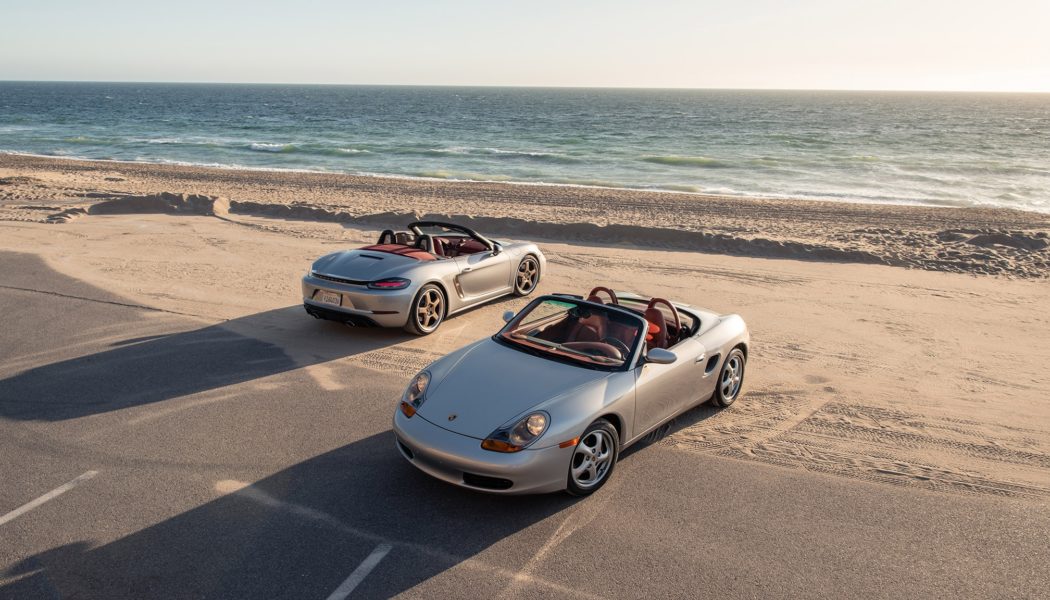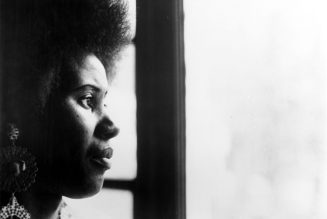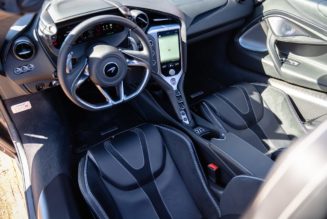“Putting Porsche in the Pink.” That was the headline on a New York Times story published on January 20, 1996, detailing the German marque’s effort to turn around its finances and reinvent the way it had built cars for more than 40 years. As the newspaper pointed out, the company that produced must-have products for the upwardly mobile during the cartoonishly decadent ’80s—in 1986, North American sales exceeded 30,000 units—had reached its last gasp. Antiquated, inefficient manufacturing processes collided head-on with an economic recession and a misjudged, aging product range to result in just 3,713 sales in the same region in 1993. Threatened with bankruptcy, Porsche had to change.
As the 968 and 928—the latter originally and inconceivably meant to replace the 911—disappeared from showrooms for good, there was a vacuum of new products as the company set about its transition. Yet even before the 993-series 911 arrived in early 1994 to barely keep the lights on, then-new CEO Wendelin Wiedeking called in automotive engineers and manufacturing gurus from Japan, who promptly turned Porsche production on its flywheel. “Just in time” manufacturing practices replaced an antiquated process whereby factory shelves were stacked with surplus parts. Gone were the inefficient manufacturing complexities that long qualified as—perhaps even defined—German “precision.”
1996 might have been the year Porsche’s self-cast lifeline became apparent to contemporary observers with a keen eye for business practices. But what occurred three years earlier, smack in front of the brand’s customers and enthusiasts, became a foundational pillar of today’s strong and healthy Porsche.
Behind the scenes, the near-term product plan called for an all-new water-cooled 911, the 996, to go on sale in the U.S. in 1998. It also called for another car: a cheaper two-seat convertible slated to arrive a year earlier and to share a significant amount of parts and panels—a practice learned from the Japanese consultants—with the flagship coupe. When Porsche pulled the cover off the little silver roadster in January 1993 at the Detroit auto show, the first tangible evidence of a new era was on full display.
The Boxster stole the show, and unlike a majority of concept cars that appear from thin air and vanish into history just as quickly, the two-seater was already greenlit for the assembly line. But the concept was actually created separately from and in parallel with the program developing a future production roadster.
“We started the show car at the end of ’91,” says Grant Larson, today the director of special projects for Porsche’s design team. As a young designer, he shot to stardom in Porsche circles after drawing the concept car under the eye of design boss Harm Lagaay. “While that was looking pretty good, I had my version of the production car going. And it was quite a bit different. The show car, it [was] just out there to showcase the idea.
“While we’re finishing the show car, the production car was in its infancy stages,” he continues. “The good thing about the concept is that it forced the production development
It’s easy to see why, beyond its objectively stunning lines: The 964-generation 911 and its 993 successor still used the famous sports car’s original 30-year-old proportions, and Porsche’s front-engine cars of the time weren’t gorgeous and failed to draw on the company’s memorable design heritage. The Boxster concept achieved the elusive product-design accomplishment of feeling both utterly fresh and classic, a borderline tableau recognizable as nothing but a Porsche. But it also avoided retro-retread cues long before “retro” design became a mainstream, cliché solution adopted by a variety of industries—even if the messaging was a bit muddled.
“When the Boxster was introduced, the Porsche press department drew a lot of parallels between it and the 550 Spyder, just because the 550 was well known,” Larson says now. “But my inspiration was the 718 RSK (seen below), which is to me the ultimate. There was this one key photo I took at the Oldtimer Grand Prix at the Nürburgring, and that 718 RSK, it was the business. Everything about it was just for me. It was the perfect, ultimate mid-engine open car. The 550 almost looks kind of toylike in comparison, the short front end and everything. But the RSK had a little more sensuality to it.”
Mention to Larson that the original Boxster’s rear end still has optical pull today, and he lights up more. “I love that little kind of bobtail rear end with the grilles,” he says in reference to his 718 RSK inspiration. “These days, you have a design idea, you have to convince everybody where you got it from. You do these things called ‘mood boards.’ But we didn’t have mood boards then. I just had a bunch of pictures of RSKs hanging up next to the sketch wall, [and] the modeler took the ideas and transplanted them to the full-size model. [I had] these key pictures of that car, like, that’s it, that’s it, that’s it: That’s the character I’d like to have. As the show car progressed in the early phases, I was trying to keep that sort of real clean, slick, timeless look—just brought up to the ’90s.
“Harm Lagaay was instrumental in pushing me to take it further. He said, ‘Now we’ve got to try more things.’ He put that S curve in the cutlines, and then he got more dramatic. He said, ‘The detail,’ and did these hand movements. ‘Just throw more. It’s a show car, just throw, just throw more on it. Let’s get more stuff on it.’ I’m going, like, ‘You know, Harm, I don’t know, is that Porsche?’
“I was crossing the bridge between my personal tastes, what I thought the car should be, and, like, total overkill. I eventually hit the sweet spot of how much stuff was on the car and how it was executed. I have to give credit to Harm; no one ever does. I get a lot of credit for that car, but I was not alone.”
Despite the concept’s exceptional presentation and its well-deserved praise, it came with one tantalizingly maddening caveat: The production version was still more than three years away.
1996 Meets 2021
What seemed like a long wait in 1993 is a drop in the sump compared to the 25 years that have passed since the 1996 Boxster reached the streets. (*It arrived in Europe for ’96 and reached the U.S. in ’97.) The model line is now woven into automotive pop culture, occasionally drawing caustic remarks as being the car for people who can’t afford a 911. At the same time, Porsche has sold nearly 360,000 examples, making it one of the company’s most successful offerings in history; only the 911 badge has endured longer among Stuttgart’s production cars.
As part of its Boxster 25 celebration, Porsche handed us not only a 2021 718 Boxster 25 Years anniversary model but also a 1997 Boxster. The ’97 version is no random example: Porsche says it’s the first production Boxster delivered to a U.S. customer, in this case comedian and Porsche collector Jerry Seinfeld. It was acquired next by Joe Cavaglieri, a vintage race car restorer with a history of working on RSKs. Porsche Cars North America purchased it from him in 2020, bringing it home to preserve.
Progress can be a tricky thing when it comes to mechanical items and recollections, especially yesteryear’s heroes so revered in their time. But arguably no carmaker has done a better job than Porsche when it comes to evolving its products across eras, of maintaining familiarity within the driving experience, the pull of a door handle, or the blat of an engine. Engineering and manufacturing have advanced far from where they were three decades ago, but the feel from behind the wheel of the 1997 is delightfully, almost shockingly recognizable.
Inside the vintage Boxster, the cockpit’s preponderance of ovoid shapes is chucklingly dated. Opposite the car’s exterior, which mostly only looks old in the sense of its size and Porsche’s budgetary and manufacturing limitations of the time, the interior seems influenced much more by period sensibilities of “futuristic.” It hasn’t aged gracefully in that sense, but this car, with 17,272 miles on its odometer and all the telltale signs of a pampered life, has been preserved spectacularly overall.
Flawless silver paint looks like you could dive into it for a swim, and Seinfeld richly specced this Boxster, taking its $40,745 base price to $65,057. Carbon-fiber trim—far from common in 1996—contributed to the cost. Today, some of these pieces show orange-peel evidence of unavoidable time-driven delamination; likewise, the clear cap over the shift pattern on top of the manual gear lever has yellowed. But that’s about it when it comes to physical signs of decay. The seat padding has lost nothing of its cushion or support, and the leather-rich interior smells just as it must have on day one. The driving position is excellent, and it’s interesting to note the steering column telescopes but does not tilt; thankfully, the vertical orientation is exactly right.
And the driving remains sublime. With the power-operated top in place, you hear creaks and rattles, largely caused by airflow bullying the plastic rear window like a trash bag caught in a cyclone. That’s modern perspective talking, though, and the Boxster is meant to be driven with its top stowed, anyway. Retract the lid, and the sounds vanish.
Find a fun, open road, and the 986 comes to life, delivering thrills despite not being quick in a straight line, even by 1990s standards: When we tested it as new, its 201-hp, 181-lb-ft 2.5-liter flat-six pushed the car’s 2,822 pounds—a weight number we wish applied to today’s performance cars—from 0 to 60 mph in 6.0 seconds and through the quarter mile in 14.5 seconds at 94.6 mph. But the original Boxster is an object lesson in why numbers aren’t always the be-all and end-all.
Let loose and driven properly, the first Boxster reminds you what driving a sports car used to mean, even if you’ve only read about such a thing in books or magazines. The 986 is one of the last cars to require drivers to really understand it in order to extract the best possible experience. This means, in the simplest terms, letting the engine run to near its 6,600-rpm redline in each gear; do so, and upshifts drop the tach needle back to the low 4,000s, square in the power and torque bands.
Keep this up in a rhythm, and the car never feels underpowered as it sashays from corner to corner, the steering light and exceptionally communicative. Overall grip is impressive as you bomb your way into and out of bends on a wave of momentum. The satisfaction intensifies by the mile as the Boxster’s limited power, its chassis balance and compliance, and the art required to drive it truly hard make for an engrossing experience. You must concentrate on your inputs if you desire to dispatch roads and corners as quickly as possible, but it’s a mellow sort of focus, not a strain-for-your-life heart attack.
Twenty miles into a drive along mountain roads, the Pacific Ocean twinkling below, you want to do this forever—or at least every weekend. If there’s a glaring negative—though perhaps this is a positive—it’s that few people who see the 986 at play are likely to have any sense of how much fun its driver is having. That, and the fact you’re now destined to scour first-gen Boxster for-sale listings on a daily basis.
Park the old baby and buckle up inside the limited-edition 2021 718 Boxster 25 Years, and the new car comes across as subtle as a jackhammer outside your bedroom window at 5 in the morning. This special edition is effectively a Boxster GTS 4.0 with stylistic nods to the original show car: silver paint; red roof and interior; copperish Neodyme five-spoke wheels, badging and air intakes; a black windshield frame; and “Boxster 25” logos in various places. (The interior and roof are available in black, the exterior in black or white.)
Next to the 1997 Boxster, the 718 may as well be a hypercar. It’s larger inside and out, of course, the exterior styling more aggressive and brash by an order of magnitude. This is still a beautiful car, even if by now, in its fourth generation, it no longer recalls classic models as much as the original does. There’s a lot more Carrera GT and 918 Spyder in this language than old road-racing Porsches. But there is no question about what it represents.
“From the very first Boxster to the current 718, we have always maintained a certain design consistency,” Larson, who contributed to the anniversary edition’s details, says. “Where the 911 has always been an evolutionary model, the Boxster has focused on younger buyers. Not only because of the price position, but how we handled the design changes throughout the generations. It was intended to take larger design steps.
“The evolution was also heavily determined by the amount of carryover parts from the 911. With the first Boxster, there were those serious financial hurdles to overcome. Throughout the generations, the car was allowed more and more to have its own individual parts such as front fenders and doors, parts that have a huge influence and dictate the overall design.”
Performance-wise, the 718 is a revolution relative to its progenitor. With 394 horsepower and 309 lb-ft of torque, we timed it from 0 to 60 mph in 4.1 seconds; the quarter mile passed in 12.2 seconds at 117.3 mph. It also pulled 1.06 g on the skidpad and stopped from 60 mph in 97 feet. Modern-day acceleration is one thing, but those skidpad and braking numbers were unthinkable for a car like this in 1996: Our test of the old Boxster yielded results of 0.94 g and 113 feet.
Over the same roads on which we drove the 986, the 718 Boxster 25 Years’ capabilities are arguably excessive. Yet, remarkably, you can feel the 986 roots in its dynamics. You must of course massively recalibrate your reference points for braking, apex speed, and how soon you can go to power on corner exit. The sport exhaust alerts canyon residents to your presence long before you’re on the scene, which isn’t an issue in the original. The PASM active suspension is both stiffer and far better at absorbing sharp impacts that can cause the 1997 Boxster to feel crashy.
The vintage model’s shifter and clutch travel are a mile long, practically buslike, versus the light-switch action of the same controls in the 718. But the modern car’s torque has the biggest effect on the experience, allowing you to keep the transmission in third gear for practically any corner. There’s no need to think about the powerband or your shift points, or to keep one eye on the tachometer—just point and go ridiculously fast. It’s a somewhat awkward sensation to reach the end of the drive route having gone massively quicker while putting in noticeably less work. It’s stark proof of modern automotive engineering’s power and how much it has altered the fundamental sports car experience.
Of course, the same thing applies to all manner of performance cars in 2021, and the market demands it. Building automobiles is an adapt-or-die business even more so today than it was in the early ’90s, back when a small German carmaker stared down its mortality and came out the other side. For its survival, give thanks in large part to an attractive little silver roadster that was and remains one of the best driver’s cars on the planet.
| SPECIFICATIONS | 2021 Porsche 718 Boxster 25th Anniversary | 1996 Porsche Boxster |
| BASE PRICE | $99,950 | $40,745 |
| PRICE AS TESTED | $103,050 | $65,057 |
| VEHICLE LAYOUT | Mid-engine, RWD, 2-pass, 2-door convertible | Mid-engine, RWD, 2-pass, 2-door convertible |
| ENGINE | 4.0L/394-hp/309-lb-ft DOHC 24-valve flat-6 | 2.5L/201-hp/181-lb-ft DOHC 24-valve flat-6 |
| TRANSMISSION | 6-speed manual | 5-speed manual |
| CURB WEIGHT (F/R DIST) | 3,144 lb (45/55%) | 2,822 lb (NA) |
| WHEELBASE | 97.4 in | 95.2 in |
| LENGTH x WIDTH x HEIGHT | 172.4 x 70.9 x 49.7 in | 171.0 x 70.1 x 50.8 in |
| 0-60 MPH | 4.1 sec | 6.0 sec |
| QUARTER MILE | 12.2 sec @ 117.3 mph | 14.5 sec @ 94.6 mph |
| BRAKING, 60-0 MPH | 97 ft | 113 ft |
| LATERAL ACCELERATION | 1.06 g (avg) | 0.94 g (avg) |
| MT FIGURE EIGHT | 23.7 sec @ 0.84 g (avg) | NA |
| EPA CITY/HWY/COMB FUEL ECON | 17/24/19 mpg | 17/24/20 mpg |
| ENERGY CONS, CITY/HWY | 198/140 kWh/100 miles | 198/140 kWh/100 miles |
| CO2 EMISSIONS, COMB | 0.99 lb/mile | 0.99 lb/mile |










